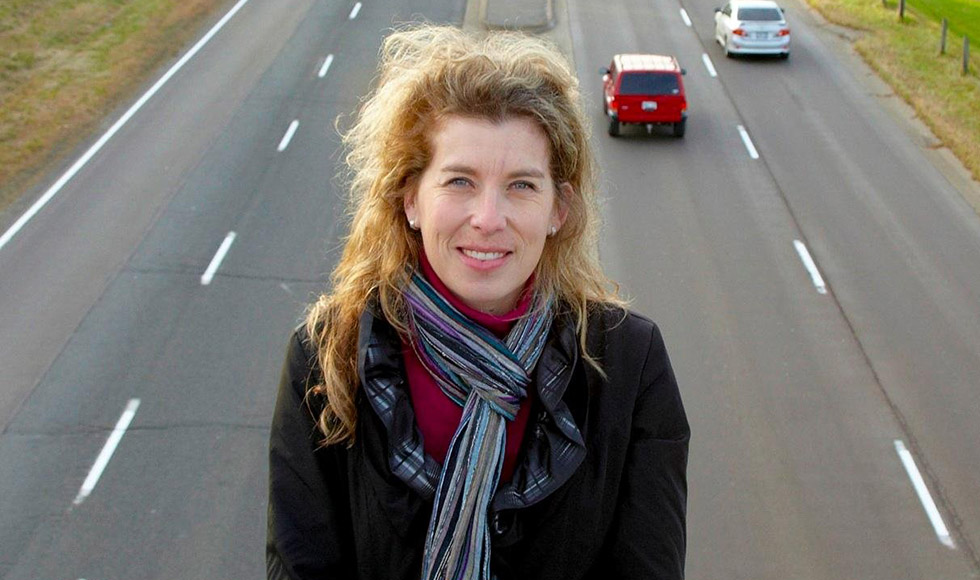Driven to improve the lives of Canada’s seniors

BY Tina Depko
March 14, 2018
It was Brenda Vrkljan’s patients who inspired her to get into research.
Working as an occupational therapist in a hospital serving a small Ontario community, Vrkljan noted the importance her patients put on returning to driving their car as soon as possible.
“Many of my patients were older and when I looked at the geography of the area, you had to drive everywhere, whether it was to the grocery store or the community centre, so it was important to them,” she said.
“When I went to the literature, there was limited evidence about how we could determine whether someone was medically fit to drive and how you could keep people behind the wheel longer.”
Driven by these motivators, Vrkljan went back to university for a PhD in rehabilitation science, with a focus on analyzing the driving habits in older Canadians.
Today, she’s an associate professor in occupational therapy at McMaster University’s School of Rehabilitation Science and the lead investigator of the McMaster-Candrive team. 
Candrive, which stands for Canadian Driving Research Initiative for Vehicular Safety in the Elderly, is an interdisciplinary, health-related research program dedicated to improving the safety and quality-of-life older drivers.
One goal of Candrive is to find a way to extend the length of time that older drivers can be behind the wheel. Another goal is to develop a screening tool that will help clinicians to identify which drivers are at risk to continue operating a motor vehicle or require a more in-depth evaluation.
“I want to keep people active and mobile in their community for as long as possible and access to transportation is important to health and well-being,” Vrkljan says.
Hamilton is a living laboratory for Vrkljan’s research. She regularly recruits local study participants, primarily older adults who are drivers that live throughout the city. Her research encompasses both quantitative and qualitative components.
“What’s great about this research is that people live their lives and we can now use GPS and small cameras to track their travel patterns by automobiles, including where they go,” she says.
“We also talk to older adults about their transportation habits through interviews and focus groups. Numbers can tell you one thing, but you also want to hear people’s narrative to identify key factors they see as important to their everyday functioning.”
Combining camera footage, GPS data and testimonials helps inform Vrkljan and her team understand driving habits and travel patterns. It also identifies opportunities for improvement when it comes to aspects like vehicle design, driver retraining, and transportation infrastructure.
For example, Vrkljan’s team is currently studying how newer automobile technology, like backup cameras and park assist, impacts the behind the wheel behaviour of older drivers.
She works closely with groups like healthcare professionals and policy makers at various levels of government when both preparing studies and disseminating results.
An absolutely wonderful experience to speak @SenateCA & on automated vehicles and seniors @MIRAMcMaster @McMasterU w Chair @dennis_dawson pic.twitter.com/vJmmBfiHEv
— Brenda V. (@BrendaVrkljan) September 26, 2017
“We want to arm clinicians, policymakers, and others with the best evidence when it comes to not only determining medical fitness-to-drive, but also promoting safe mobility,” Vrkljan says.
She says her research is important because loss of driving has negative consequences on a person’s quality of life, as well as those around them.
“When people stop driving, whether it is voluntary or otherwise, it has huge implications, including depression and social isolation,” she says.
“We need to remember it also has implications on caregivers and people can end up institutionalized more quickly.”
Looking to the future, Vrkljan sees a further focus of her research on how communities may be designed to promote aging-in-place of choice. She is excited to collaborate with faculty from engineering, geography, social science and others that are part of the McMaster Institute for Research on Aging. Vrkljan notes Canada has many challenges with its urban sprawl and deficiency of alternative transportation options in suburban as well as rural areas.
“I want to look at how we can design environments that promote safe mobility,” she says.
When Vrkljan is off campus, she catches herself noting driver behaviour, both on and off the road.
“Everywhere I go, I am always watching driver habits,” she says. “I watch how people get in and out of their vehicles, recognizing the impact vehicle height can have. My research is always on my mind.”
Mary Law, professor emeritus and former associate dean of the School of Rehabilitation Science, was actively involved with the search committee which hired Vrkljan in 2006. Law says Vrkljan was selected for her enthusiasm, her expertise in working with older adults and the potential for her research program.
Vrkljan’s research plays a key role in tackling challenging issues facing older adults, their mobility and their everyday functioning in our communities, according to Law.
“Citizens within Canada count on driving throughout their lifetime to enable them to travel to work, recreational activities and to do chores,” says Law.
“Our communities often lack efficient public transportation so we remain dependent on driving our cars. Brenda’s research addresses many of the key issues about driving and transportation that are facing Canadian seniors today. Her findings will contribute to improving driver safety and enhancing the ability of seniors to maintain their travel independence.”
Vrkljan, who received a YWCA Woman of Distinction Award for mentorship in 2016, says she hopes her passion for her research will help create a strong and vibrant community of future experts in the field.
“The biggest legacy I can have is training the next generation of caring clinicians in the field of rehabilitation science who ask good questions and do important research that improves the health and quality of life of all Canadians.”


